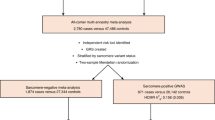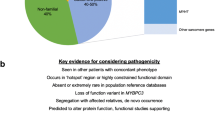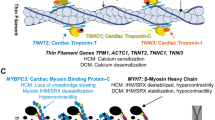Abstract
Despite considerable progress in identifying and modifying risk factors that cause cardiovascular disease, heart failure has emerged as an important medical and socioeconomic problem. Hypertrophic remodeling, a common response to many cardiovascular disorders, increases the risk of heart failure. Discovery of the genetic basis of hypertrophic cardiomyopathy has allowed consideration of whether these genes also contribute to pathologic remodeling that occurs in the context of common acquired cardiovascular disorders. Evidence supporting a shared etiology has emerged from the recent identification of sarcomere protein mutations and sequence variants in community-based populations with hypertrophy and heart failure. These findings imply that harnessing genetic testing for hypertrophic mutations may help define patients at risk for heart failure. In the future, mechanistic insights into hypertrophic remodeling, combined with strategies to prevent this pathology, are expected to reduce the burden of heart failure.


Similar content being viewed by others
References
American Heart Association. (2009). Heart disease and stroke statistics—2009 update. Dallas: American Heart Association.
Arad, M., Maron, B. J., Gorham, J. M., Johnson, W. H., Jr., Saul, J. P., Perez-Atayde, A. R., et al. (2005). Glycogen storage diseases presenting as hypertrophic cardiomyopathy. The New England Journal of Medicine, 352, 362–372.
Arimura, T., Bos, J. M., Sato, A., Kubo, T., Okamoto, H., Nishi, H., et al. (2009). Cardiac ankyrin repeat protein gene (ANKRD1) mutations in hypertrophic cardiomyopathy. Journal of the American College of Cardiology, 54, 334–342.
Arnett, D. K., Devereux, R. B., Rao, D. C., Li, N., Tang, W., Kraemer, R., et al. (2009). Novel genetic variants contributing to left ventricular hypertrophy: The HyperGEN study. Journal of Hypertension, 27, 1585–1593.
Bos, J. M., Towbin, J. A., & Ackerman, M. J. (2009). Diagnostic, prognostic, and therapeutic implications of genetic testing for hypertrophic cardiomyopathy. Journal of the American College of Cardiology, 54, 201–211.
Carniel, E., Taylor, M. R., Sinagra, G., Di Lenarda, A., Ku, L., Fain, P. R., et al. (2005). Alpha-myosin heavy chain: a sarcomeric gene associated with dilated and hypertrophic phenotypes of cardiomyopathy. Circulation, 112, 54–59.
Cohen, J. C., Kiss, R. S., Pertsemlidis, A., Marcel, Y. L., McPherson, R., & Hobbs, H. H. (2004). Multiple rare alleles contribute to low plasma levels of HDL cholesterol. Science, 305, 869–872.
Cohen, J. C., Boerwinkle, E., Mosley, T. H., Jr., & Hobbs, H. H. (2006). Sequence variations in PCSK9, low LDL, and protection against coronary heart disease. The New England Journal of Medicine, 354, 1264–1272.
Daw, E. W., Chen, S. N., Czernuszewicz, G., Lombardi, R., Lu, Y., Ma, J., et al. (2007). Genome-wide mapping of modifier chromosomal loci for human hypertrophic cardiomyopathy. Human Molecular Genetics, 16, 2463–2471.
Dhandapany, P. S., Sadayappan, S., Xue, Y., Powell, G. T., Rani, D. S., Nallari, P., et al. (2009). A common MYBPC3 (cardiac myosin binding protein C) variant associated with cardiomyopathies in South Asia. Nature Genetics, 41, 187–191.
Drazner, M. H., Rame, J. E., Marino, E. K., Gottdiener, J. S., Kitzman, D. W., Gardin, J. M., et al. (2004). Increased left ventricular mass is a risk factor for the development of a depressed left ventricular ejection fraction within five years: The Cardiovascular Health Study. Journal of the American College of Cardiology, 43, 2207–2215.
Ehlermann, P., Weichenhan, D., Zehelein, J., Steen, H., Pribe, R., Zeller, R., et al. (2008). Adverse events in families with hypertrophic or dilated cardiomyopathy and mutations in the MYBPC3 gene. BMC Medical Genetics, 9, 95.
Flavigny, J., Souchet, M., Sebillon, P., Berrebi-Bertrand, I., Hainque, B., Mallet, A., et al. (1999). COOH-terminal truncated cardiac myosin-binding protein C mutants resulting from familial hypertrophic cardiomyopathy mutations exhibit altered expression and/or incorporation in fetal rat cardiomyocytes. Journal of Molecular Biology, 294, 443–456.
Gardin, J. M., McClelland, R., Kitzman, D., Lima, J. A., Bommer, W., Klopfenstein, H. S., et al. (2001). M-mode echocardiographic predictors of six- to seven-year incidence of coronary heart disease, stroke, congestive heart failure, and mortality in an elderly cohort (the Cardiovascular Health Study). The American Journal of Cardiology, 87, 1051–1057.
Geier, C., Perrot, A., Ozcelik, C., Binner, P., Counsell, D., Hoffmann, K., et al. (2003). Mutations in the human muscle LIM protein gene in families with hypertrophic cardiomyopathy. Circulation, 107, 1390–1395.
Ghali, J. K., Liao, Y., Simmons, B., Castaner, A., Cao, G., & Cooper, R. S. (1992). The prognostic role of left ventricular hypertrophy in patients with or without coronary artery disease. Annals of Internal Medicine, 117, 831–836.
Gupta, R. M., Pais, A., Rastogi, P., & Gupta, V. P. (2006). Correlation of regional cardiovascular mortality in India with lifestyle and nutritional factors. International Journal of Cardiology, 108, 291–300.
Hayashi, T., Arimura, T., Itoh-Satoh, M., Ueda, K., Hohda, S., Inagaki, N., et al. (2004). TCAP gene mutations in hypertrophic cardiomyopathy and dilated cardiomyopathy. Journal of the American College of Cardiology, 44, 2192–2201.
Hershberger, R. E., Cowan, J., Morales, A., & Siegfried, J. D. (2009). Progress with genetic cardiomyopathies: screening, counseling, and testing in dilated, hypertrophic, and arrhythmogenic right ventricular dysplasia/cardiomyopathy. Circulation: Heart Failure, 2, 253–261.
Holm, H., Gudbjartsson, D. F., Arnar, D. O., Thorleifsson, G., Thorgeirsson, G., Stefansdottir, H., et al. (2010). Several common variants modulate heart rate, PR interval and QRS duration. Nature Genetics, 42, 117–122.
Ingles, J., Doolan, A., Chiu, C., Seidman, J., Seidman, C., & Semsarian, C. (2005). Compound and double mutations in patients with hypertrophic cardiomyopathy: implications for genetic testing and counselling. Journal of Medical Genetics, 42, e59.
Jaaskelainen, P., Kuusisto, J., Miettinen, R., Karkkainen, P., Karkkainen, S., Heikkinen, S., et al. (2002). Mutations in the cardiac myosin-binding protein C gene are the predominant cause of familial hypertrophic cardiomyopathy in eastern Finland. Journal of Molecular Medicine, 80, 412–422.
Kathiresan, S., Melander, O., Guiducci, C., Surti, A., Burtt, N. P., Rieder, M. J., et al. (2008). Six new loci associated with blood low-density lipoprotein cholesterol, high-density lipoprotein cholesterol or triglycerides in humans. Nature Genetics, 40, 189–197.
Landstrom, A. P., Weisleder, N., Batalden, K. B., Bos, J. M., Tester, D. J., Ommen, S. R., et al. (2007). Mutations in JPH2-encoded junctophilin-2 associated with hypertrophic cardiomyopathy in humans. Journal of Molecular and Cellular Cardiology, 42, 1026–1035.
Levy, D., Garrison, R. J., Savage, D. D., Kannel, W. B., & Castelli, W. P. (1990). Prognostic implications of echocardiographically determined left ventricular mass in the Framingham Heart Study. The New England Journal of Medicine, 322, 1561–1566.
Lind, J. M., Chiu, C., Ingles, J., Yeates, L., Humphries, S. E., Heather, A. K., et al. (2008). Sex hormone receptor gene variation associated with phenotype in male hypertrophic cardiomyopathy patients. Journal of Molecular and Cellular Cardiology, 45, 217–222.
Lloyd-Jones, D., Adams, R., Carnethon, M., De Simone, G., Ferguson, T. B., Flegal, K., et al. (2009). Heart disease and stroke statistics—2009 update: a report from the American Heart Association Statistics Committee and Stroke Statistics Subcommittee. Circulation, 119, 480–486.
Maron, B. J. (2002). Hypertrophic cardiomyopathy: a systematic review. Journal of the American Medical Association, 287, 1308–1320.
Maron, B. J. (2003). Sudden death in young athletes. The New England Journal of Medicine, 349, 1064–1075.
Maron, B. (2008). Hypertrophic cardiomyopathy. In P. Libby, R. Bonow, D. Zipes, & D. Mann (Eds.), Braunwald's heart disease. A textbook of cardiovascular medicine (8th ed., pp. 1763–1774). Maryland Heights: Elsevier.
Maron, B. J., Gardin, J. M., Flack, J. M., Gidding, S. S., Kurosaki, T. T., & Bild, D. E. (1995). Prevalence of hypertrophic cardiomyopathy in a general population of young adults. Echocardiographic analysis of 4111 subjects in the CARDIA Study. Coronary Artery Risk Development In (young) Adults. Circulation, 92, 785–789.
Maron, B. J., Seidman, J. G., & Seidman, C. E. (2004). Proposal for contemporary screening strategies in families with hypertrophic cardiomyopathy. Journal of the American College of Cardiology, 44, 2125–2132.
Marston, S., Copeland, O., Jacques, A., Livesey, K., Tsang, V., McKenna, W. J., et al. (2009). Evidence from human myectomy samples that MYBPC3 mutations cause hypertrophic cardiomyopathy through haploinsufficiency. Circulation Research, 105, 219–222.
Mayosi, B. M., Avery, P. J., Farrall, M., Keavney, B., & Watkins, H. (2008). Genome-wide linkage analysis of electrocardiographic and echocardiographic left ventricular hypertrophy in families with hypertension. European Heart Journal, 29, 525–530.
McPherson, R., Pertsemlidis, A., Kavaslar, N., Stewart, A., Roberts, R., Cox, D. R., et al. (2007). A common allele on chromosome 9 associated with coronary heart disease. Science, 316, 1488–1491.
Morita, H., DePalma, S. R., Arad, M., McDonough, B., Barr, S., Duffy, C., et al. (2002). Molecular epidemiology of hypertrophic cardiomyopathy. Cold Spring Harbor Symposia on Quantitative Biology, 67, 383–388.
Morita, H., Seidman, J., & Seidman, C. E. (2005). Genetic causes of human heart failure. Journal of Clinical Investigation, 115, 518–526.
Morita, H., Larson, M. G., Barr, S. C., Vasan, R. S., O'Donnell, C. J., Hirschhorn, J. N., et al. (2006). Single-gene mutations and increased left ventricular wall thickness in the community: The Framingham Heart Study. Circulation, 113, 2697–2705.
Morita, H., Rehm, H. L., Menesses, A., McDonough, B., Roberts, A. E., Kucherlapati, R., et al. (2008). Shared genetic causes of cardiac hypertrophy in children and adults. The New England Journal of Medicine, 358, 1899–1908.
Nakao, S., Takenaka, T., Maeda, M., Kodama, C., Tanaka, A., Tahara, M., et al. (1995). An atypical variant of Fabry's disease in men with left ventricular hypertrophy. The New England Journal of Medicine, 333, 288–293.
Niimura, H., Bachinski, L. L., Sangwatanaroj, S., Watkins, H., Chudley, A. E., McKenna, W., et al. (1998). Mutations in the gene for cardiac myosin-binding protein C and late-onset familial hypertrophic cardiomyopathy. The New England Journal of Medicine, 338, 1248–1257.
Niimura, H., Patton, K. K., McKenna, W. J., Soults, J., Maron, B. J., Seidman, J. G., et al. (2002). Sarcomere protein gene mutations in hypertrophic cardiomyopathy of the elderly. Circulation, 105, 446–451.
Okura, Y., Ramadan, M. M., Ohno, Y., Mitsuma, W., Tanaka, K., Ito, M., et al. (2008). Impending epidemic: Future projection of heart failure in Japan to the year 2055. Circulation Journal, 72, 489–491.
Olivotto, I., Girolami, F., Ackerman, M. J., Nistri, S., Bos, J. M., Zachara, E., et al. (2008). Myofilament protein gene mutation screening and outcome of patients with hypertrophic cardiomyopathy. Mayo Clinic Proceedings, 83, 630–638.
Osio, A., Tan, L., Chen, S. N., Lombardi, R., Nagueh, S. F., Shete, S., et al. (2007). Myozenin 2 is a novel gene for human hypertrophic cardiomyopathy. Circulation Research, 100, 766–768.
Perkins, M. J., Van Driest, S. L., Ellsworth, E. G., Will, M. L., Gersh, B. J., Ommen, S. R., et al. (2005). Gene-specific modifying effects of pro-LVH polymorphisms involving the renin–angiotensin–aldosterone system among 389 unrelated patients with hypertrophic cardiomyopathy. European Heart Journal, 26, 2457–2462.
Petretto, E., Sarwar, R., Grieve, I., Lu, H., Kumaran, M. K., Muckett, P. J., et al. (2008). Integrated genomic approaches implicate osteoglycin (Ogn) in the regulation of left ventricular mass. Nature Genetics, 40, 546–552.
Pfeufer, A., van Noord, C., Marciante, K. D., Arking, D. E., Larson, M. G., Smith, A. V., et al. (2010). Genome-wide association study of PR interval. Nature Genetics, 42, 153–161.
Richard, P., Charron, P., Carrier, L., Ledeuil, C., Cheav, T., Pichereau, C., et al. (2003). Hypertrophic cardiomyopathy: distribution of disease genes, spectrum of mutations, and implications for a molecular diagnosis strategy. Circulation, 107, 2227–2232.
Seidman, J. G., & Seidman, C. (2001). The genetic basis for cardiomyopathy: from mutation identification to mechanistic paradigms. Cell, 104, 557–567.
van Dijk, S. J., Dooijes, D., dos Remedios, C., Michels, M., Lamers, J. M., Winegrad, S., et al. (2009). Cardiac myosin-binding protein C mutations and hypertrophic cardiomyopathy: Haploinsufficiency, deranged phosphorylation, and cardiomyocyte dysfunction. Circulation, 119, 1473–1483.
Van Driest, S. L., Jaeger, M. A., Ommen, S. R., Will, M. L., Gersh, B. J., Tajik, A. J., et al. (2004). Comprehensive analysis of the beta-myosin heavy chain gene in 389 unrelated patients with hypertrophic cardiomyopathy. Journal of the American College of Cardiology, 44, 602–610.
Vasile, V. C., Will, M. L., Ommen, S. R., Edwards, W. D., Olson, T. M., & Ackerman, M. J. (2006). Identification of a metavinculin missense mutation, R975W, associated with both hypertrophic and dilated cardiomyopathy. Molecular Genetics and Metabolism, 87, 169–174.
Volkmann, N., Lui, H., Hazelwood, L., Trybus, K. M., Lowey, S., & Hanein, D. (2007). The R403Q myosin mutation implicated in familial hypertrophic cardiomyopathy causes disorder at the actomyosin interface. PLoS ONE, 2, e1123.
Watkins, H., McKenna, W. J., Thierfelder, L., Suk, H. J., Anan, R., O'Donoghue, A., et al. (1995). Mutations in the genes for cardiac troponin T and alpha-tropomyosin in hypertrophic cardiomyopathy. The New England Journal of Medicine, 332, 1058–1064.
Williams, L., & Frenneaux, M. (2007). Syncope in hypertrophic cardiomyopathy: Mechanisms and consequences for treatment. Europace, 9, 817–822.
Willott, R. H., Gomes, A. V., Chang, A. N., Parvatiyar, M. S., Pinto, J. R., & Potter, J. D. (2010). Mutations in troponin that cause HCM, DCM AND RCM: What can we learn about thin filament function? Journal of Molecular and Cellular Cardiology, 48, 882–892.
Acknowledgements
This work was supported, in part, by grants from the Ministry of Education, Culture, Sports, Science, and Technology of Japan (H.M. and R.N.), the TAKEDA Science Foundation (H.M.), the National Institutes of Health (J.G.S. and C.E.S.), the Leducq Foundation (J.G.S. and C.E.S.), and the Howard Hughes Medical Institute (C.E.S.).
Author information
Authors and Affiliations
Corresponding author
Rights and permissions
About this article
Cite this article
Morita, H., Nagai, R., Seidman, J.G. et al. Sarcomere Gene Mutations in Hypertrophy and Heart Failure. J. of Cardiovasc. Trans. Res. 3, 297–303 (2010). https://doi.org/10.1007/s12265-010-9188-4
Received:
Accepted:
Published:
Issue Date:
DOI: https://doi.org/10.1007/s12265-010-9188-4




